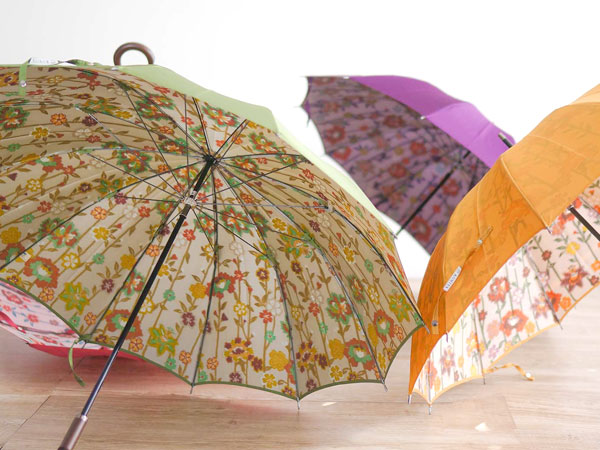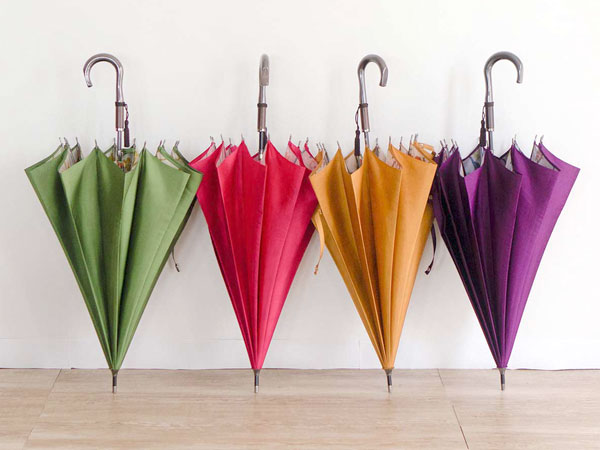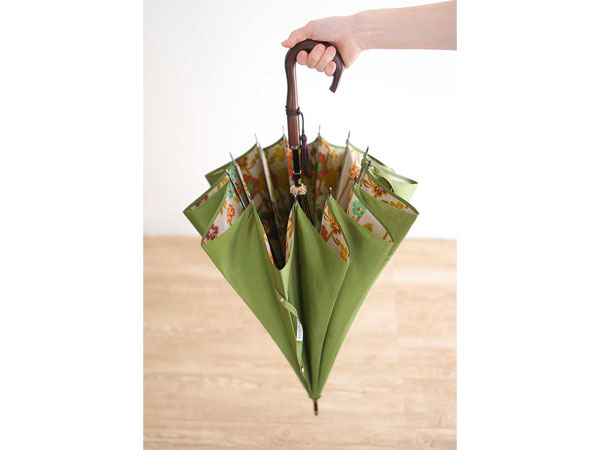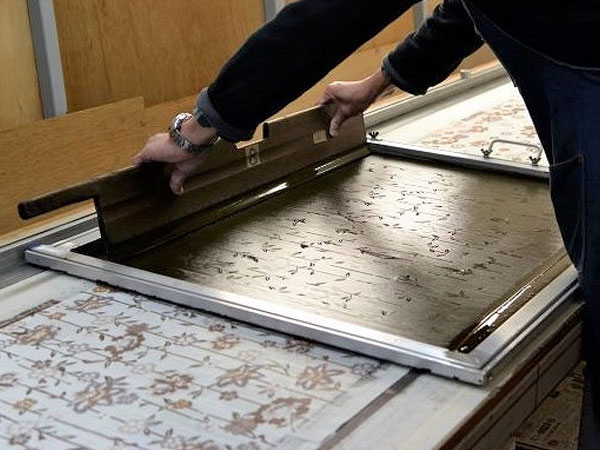
The material used for this umbrella is Koshu weave, a fabric made specifically for umbrellas, woven in Fujiyoshida, Yamanashi Prefecture, a place long known for its umbrellas!
Koshu weave is originally woven to fit the width of the umbrella, so unlike regular umbrellas, there are no perforations at the tip of the umbrella fabric, making it both smart looking and durable!
One of the attractions of Koshu weaving is its elegant and heavy feel and texture.
The yarn-dyed "hogushiori" fabric, which is known for its delicate and soft patterns, is further woven with colored threads to create an umbrella with a plain exterior and a vivid, deep Japanese floral pattern on the interior.
The super lightweight carbon fiber ribs make it easy to carry.
While mass-produced umbrellas are the norm, Koshu-ori umbrellas are handmade one by one and can only be made in limited numbers, making them a rare, high-quality umbrella in both fabric and construction.
We deliver original umbrellas made from authentic Koshu weaving, each one handmade by a craftsman with over 50 years of experience!
Each umbrella is handmade


Komiya, who has a wealth of experience, works with veteran craftsmen with over 30 years of experience in the field, and is only able to produce a maximum of about 10 pieces a day in his workshop.
"Each one is handmade, so we can't make them in large quantities.
Nowadays, there are fewer craftsmen who can make fabric specifically for umbrellas, and Koshu-ori umbrellas themselves are becoming very rare.
With mass-produced umbrellas becoming mainstream and genuine umbrellas becoming scarce, we have customers who own several of our umbrellas, and it makes us happy when customers say they've found a one-of-a-kind umbrella that they'll never own again."
(Producer Komiya)
The elegant and heavy texture of the yarn-dyed fabric!
Koshu weave is made by dyeing the threads before weaving, so you can enjoy the heavy feel and texture created by the warp and weft threads, which has an elegant and slightly retro atmosphere!
Lightweight! Ultra-lightweight carbon ribs are used.
This umbrella is lightweight and easy to carry around, thanks to its ultra-lightweight carbon fiber ribs that are strong, lightweight, and rust-resistant!
Handle shaped to fit your hand!

The handle is shaped to fit comfortably in your hand!
"We always try to create a handle that is easy to grip."
(Producer Komiya)
Umbrellas are auspicious items that bring good fortune!
Umbrellas are considered to be auspicious items that bring prosperity, making them the perfect gift for celebrations, anniversaries, Father's Day, Mother's Day, and more!
How Koshu-ori umbrellas are made.
 It is said that there are more than 50 steps in the process of making an umbrella.
It is said that there are more than 50 steps in the process of making an umbrella.
Komiya, who has a wealth of experience, works with veteran craftsmen with over 30 years of experience in the field, and is only able to produce a maximum of about 10 pieces a day in his workshop.
Komiya carefully crafts each and every Koshu-ori umbrella .
(1) Cutting and stitching : After specifying the design, color, and pattern, the 100% polyester Koshu-woven umbrella fabric is woven and cut to fit the umbrella specifications.
Then, the fabric is sewn together to fit the shape of the bones using waxed thread.
Komiya uses durable domestic materials for the umbrella fabric and handles.
"Currently, low-priced products made overseas dominate the umbrella market, but
"Umbrellas are delicate products, with small parts and thin ribs, so if handled improperly, they will break easily. That's why we make our umbrellas using the strongest domestic materials possible," says producer Komiya.
(2) Wrapping on the potter's wheel, attaching the dowels, and attaching the dew tip
A part called a rokuro, which holds the ribs of the umbrella together, is attached.
Then, after attaching the joint between the main rib and the support rib, called a dowel, a part called a "tsuyusaki" is attached to the tip of the rib, which spreads out at the end.
For long umbrellas, protect the rollers and dowels with cloth.
(3) The fabric is placed on the frame, which is then fastened, finished, and attached to the handle , and carefully attached with waxed thread.
After finishing the fine details and adding the hands, it's complete.
"The handle is the last part that is attached, which is the face of the umbrella. That's why I try to make it as unique as possible, by adding tassels, etc." (Producer Komiya)
What is a Koshu-ori umbrella?
Fujiyoshida in Yamanashi Prefecture, Japan's leading producer of umbrella fabric, is the birthplace of Koshu-ori, a fabric with a long tradition that is often compared to Nishijin-ori.
It is said that Koshu weaving originated when a servant of Qin Shi Huang (!) who came to Mount Fuji in search of the elixir of immortality brought weaving techniques to the area.
Koshu weaving is not dyed after weaving, but rather the threads are dyed before being woven, resulting in an elegant and heavy feel and texture created by the interweaving of warp and weft threads.
"Our predecessor was originally from Koshu, so we have been making authentic Koshu weaving for over 70 years since our founding," says producer Komiya.
We also offer after-sales service!
This umbrella is a strong one, but if it does break over the years of use, you can have it repaired.
"I would be happy if you would use it for a long time and cherish it," says producer Komiya.
*Repair costs and shipping fees are separate.
*Please feel free to contact us with any inquiries.
Care:
After use, lightly wipe the fabric and ribs and dry in the shade to keep your umbrella in good condition.
When washing, use a mild detergent and a soft sponge and dry in the shade.
These original umbrellas are made with traditional Koshu-ori fabric, a traditional umbrella material that is imbued with the craftsman's attention to detail and consideration for the user! It makes me happy when customers say they've found a one-of-a-kind umbrella that they'll only own once in their lifetime.
Please try out our sturdy umbrellas, which are handmade one by one by artisans and not found in mass-produced umbrellas.
Size: Open diameter: approx. 96cm
Weight: approx. 375g